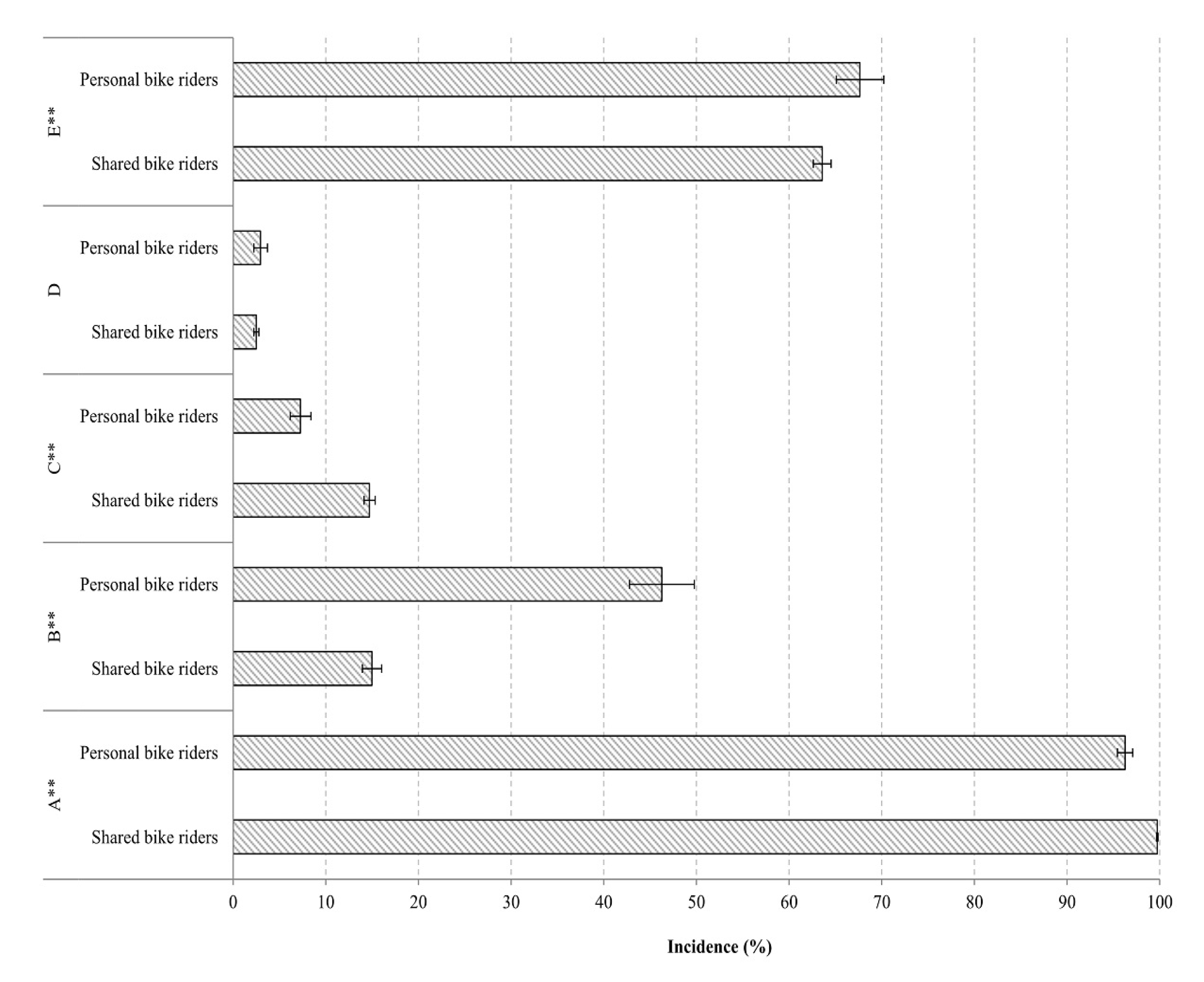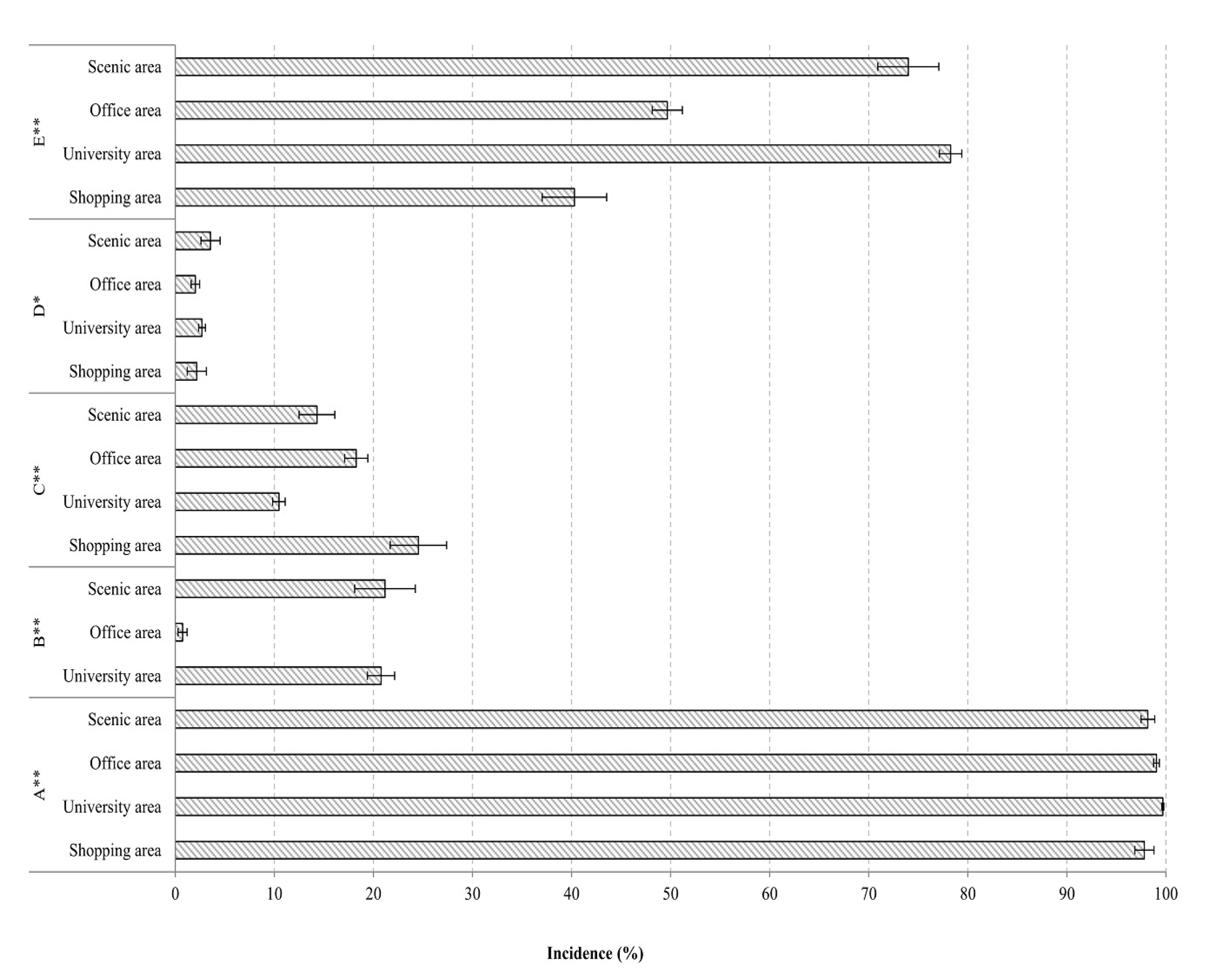Unsafe Bicycling Behavior in Changsha, China: A Video-Based Observational Study
Abstract
1. Introduction
2. Materials and Methods
2.1. Study Location and Participants
2.2. Ethical Approval
2.3. Video-Based Data Collection
2.4. Video Coding
2.5. Statistical Analysis
3. Results
4. Discussion
5. Conclusions
Author Contributions
Funding
Conflicts of Interest
References
- Zhou, M.; Hu, G.; Wang, L.; Ma, S.; Li, Q.; Hyder, A.A. Bicyclist mortality between 2006 and 2010 in China: Findings from national Disease Surveillance Points (DSP) data. Inj. Prev. 2014, 20, 7–10. [Google Scholar] [CrossRef]
- Fu, C.; Guo, Q. Road traffic injuries in shared bicycle riders in China. Lancet Public Health 2018, 3, e111. [Google Scholar] [CrossRef]
- Beijing Tsinghua Tongheng Innovation Institute of Planning, Design, and Research Technology. White Book of Shared Bike and City Development. 2017. (In Chinese). Available online: https://wenku.baidu.com/view/c94081f10408763231126edb6f1aff00bfd57066.html (accessed on 23 November 2019).
- Hu, G.; Yin, D. China: A return to the “kingdom of bicycles”? BMJ 2018, 360, k94. [Google Scholar] [CrossRef]
- The Central People’s Government of the People’s Republic of China. Ten Departments of Transportation and Other Departments’ Guidance on Encouraging and Regulating the Development of Internet Rental Bicycles. 2017; (In Chinese). Available online: http://www.gov.cn/xinwen/2017-08/03/content_5215640.htm (accessed on 15 December 2019).
- Zhang, Y.; Thomas, T.; Brussel, M.J.G.; Van Maarseveen, M.F. Expanding Bicycle-Sharing Systems: Lessons Learnt from an Analysis of Usage. PLoS ONE 2016, 11, e0168604. [Google Scholar] [CrossRef]
- Institute for Health Metrics and Evaluation. Global Burden of Disease. Compare Viz Hub. 2017. Available online: https://vizhub.healthdata.org/gbd-compare/ (accessed on 16 December 2019).
- Wu, X.; Xiao, W.; Deng, C.; Schwebel, D.C.; Hu, G. Unsafe riding behaviors of shared-bicycle riders in urban China: A retrospective survey. Accid. Anal. Prev. 2019, 131, 1–7. [Google Scholar] [CrossRef]
- Wu, C.; Yao, L.; Zhang, K. The red-light running behavior of electric bike riders and cyclists at urban intersections in China: An observational study. Accid. Anal. Prev. 2012, 49, 186–192. [Google Scholar] [CrossRef]
- Du, W.; Yang, J.; Powis, B.; Zheng, X.; Ozanne-Smith, J.; Bilston, L.; Wu, M. Understanding on-road practices of electric bike riders: An observational study in a developed city of China. Accid. Anal. Prev. 2013, 59, 319–326. [Google Scholar] [CrossRef]
- Goodman, A.; Green, J.; Woodcock, J. The role of bicycle sharing systems in normalising the image of cycling: An observational study of London cyclists. J. Transp. Health 2014, 1, 5–8. [Google Scholar] [CrossRef]
- Kraemer, J.D.; Roffenbender, J.S.; Anderko, L. Helmet wearing among users of a public bicycle-sharing program in the District of Columbia and comparable riders on personal bicycles. Am. J. Public Health 2012, 102, e23–e25. [Google Scholar] [CrossRef]
- Bonyun, M.; Camden, A.; MacArthur, C.; Howard, A. Helmet use in BIXI cyclists in Toronto, Canada: An observational study. BMJ Open 2012, 2, e001049. [Google Scholar] [CrossRef]
- Zanotto, M.; Winters, M.L. Helmet use among personal bicycle riders and bike share users in Vancouver, BC. Am. J. Prev. Med. 2017, 53, 465–472. [Google Scholar] [CrossRef]
- Wolfe, E.S.; Arabian, S.S.; Salzler, M.J.; Bugaev, N.; Rabinovici, R. Bicyclist safety behaviors in an urban northeastern, United States city: An observational study. J. Trauma. Nurs. 2016, 23, 119–124. [Google Scholar] [CrossRef]
- Grenier, T.; Deckelbaum, D.L.; Boulva, K.; Drudi, L.; Feyz, M.; Rodrigue, N.; Tze, N.; Fata, P.; Khwaja, K.; Chughtai, T.; et al. A descriptive study of bicycle helmet use in Montreal, 2011. Can. J. Public Health 2013, 104, e400–e404. [Google Scholar] [CrossRef]
- Chen, G.Z. “Big Data” of Changsha Cycling Released by a Shared Bicycle Company. Hunan Daily. 2017. (In Chinese). Available online: http://hnrb.voc.com.cn/hnrb_epaper/html/2017-05/24/content_1214949.htm?div=-1 (accessed on 23 November 2019).
- Tuckel, P.; Milczarski, W. City Cyclists Ride More Safely: An Observational Study of Biking Behavior in Lower and Central Manhattan. 2013. Available online: http://c.ymcdn.com/sites/www.apbp.org/resource/collection/5DE92501-A2C5-485C-A537-428A1C913C93/City_Cyclists_Ride_More_Safely_Milczarski_May-13.pdf (accessed on 5 October 2019).
- The Central People’s Government of the People’s Republic of China. The Implementation Regulations of Road Traffic Safety Law of the People’s Republic of China. 2005; (In Chinese). Available online: http://www.gov.cn/banshi/2005-08/23/content_25579.htm (accessed on 21 March 2019).
- Son, S.H.; Oh, S.H.; Kang, S.H.; Kim, D.-K.; Seo, K.M.; Lee, S.-U.; Lee, S.-Y. Independent factors associated with bicycle helmet use in a Korean population: A cross-sectional study. Traffic Inj. Prev. 2018, 19, 399–403. [Google Scholar] [CrossRef]
- Fischer, C.M.; Sanchez, C.E.; Pittman, M.; Milzman, D.; Volz, K.A.; Huang, H.; Gautam, S.; Sanchez, L.D. Prevalence of bicycle helmet use by users of public bikeshare programs. Ann. Emerg. Med. 2012, 60, 228–231. [Google Scholar] [CrossRef]
- Basch, C.H.; Ethan, D.; Rajan, S.; Samayoa-Kozlowsky, S.; Basch, C.E. Helmet use among users of the Citi Bike bicycle-sharing program: A pilot study in New York City. J. Commun. Health 2014, 39, 503–507. [Google Scholar] [CrossRef]
- Popa, I.; Ferraro, O.E.; Orsi, C.; Morandi, A.; Montomoli, C. Bicycle helmet use patterns in Italy. A description and analysis of survey data from an Italian friends of cycling association. Accid. Anal. Prev. 2017, 108, 268–274. [Google Scholar] [CrossRef]
- Hoye, A. Recommend or mandate? A systematic review and meta-analysis of the effects of mandatory bicycle helmet legislation. Accid. Anal. Prev. 2018, 120, 239–249. [Google Scholar] [CrossRef]
- Chow, R.; Hollenberg, D.; Pintilie, A.; Midroni, C.; Cumner, S. Helmet use of adolescent cyclists at Crescent School in Toronto, Canada. Int. J. Adolesc. Med. Health 2016, 29. [Google Scholar] [CrossRef]
- Finnoff, J.T.; Laskowski, E.R.; Altman, K.L.; Diehl, N.N. Barriers to bicycle helmet use. Pediatrics 2001, 108, E4. [Google Scholar] [CrossRef]
- Bai, L.; Liu, P.; Guo, Y.; Yu, H. Comparative analysis of risky behaviors of electric bicycles at signalized intersections. Traff. Inj. Prev. 2015, 16, 424–428. [Google Scholar] [CrossRef]
- Richardson, M.; Caulfield, B. Investigating traffic light violations by cyclists in Dublin city centre. Accid. Anal. Prev. 2015, 4, 65–73. [Google Scholar] [CrossRef]
- Fraboni, F.; Puchades, V.M.; De Angelis, M.; Pietrantoni, L.; Prati, G. Red-light running behavior of cyclists in Italy: An observational study. Accid. Anal. Prev. 2018, 120, 219–232. [Google Scholar] [CrossRef]
- Schleinitz, K.; Petzoldt, T.; Kröling, S.; Gehlert, T.; Mach, S. (E-)Cyclists running the red light—The influence of bicycle type and infrastructure characteristics on red light violations. Accid. Anal. Prev. 2019, 122, 99–107. [Google Scholar] [CrossRef]
- Parker, K.M.; Rice, J.; Gustat, J.; Ruley, J.; Spriggs, A.; Johnson, C. Effect of bike lane infrastructure improvements on ridership in one New Orleans neighborhood. Ann. Behav. Med. 2013, 45 (Suppl. S1), S101–S107. [Google Scholar] [CrossRef]
- De Waard, D.; Westerhuis, F.; Lewis-Evans, B. More screen operation than calling: The results of observing cyclists’ behavior while using mobile phones. Accid. Anal. Prev. 2015, 76, 42–48. [Google Scholar] [CrossRef]
- Schwebel, D.C.; Stavrinos, D.; Byington, K.W.; Davis, T.; O’Neal, E.E.; de Jong, D. Distraction and pedestrian safety: How talking on the phone, texting, and listening to music impact crossing the street. Accid. Anal. Prev. 2012, 45, 266–271. [Google Scholar] [CrossRef]
- Jia, Y.; Ding, D.; Gebel, K.; Chen, L.; Zhang, S.; Ma, Z.; Fu, H. Effects of new dock-less bicycle-sharing programs on cycling: A retrospective study in Shanghai. BMJ Open 2019, 9, e024280. [Google Scholar] [CrossRef]
- Friedman, S.M.; Adamson, M.; Cleiman, P.; Arenovich, T.; Oleksak, K.; Mohabir, I.M.; Ta, R.; Reiter, K. Helmet-wearing practices and barriers in Toronto bike-share users: A case-control study. Can. J. Emerg. Med. 2016, 18, 28–36. [Google Scholar] [CrossRef][Green Version]
- Yuan, C.; Sun, Y.; Lv, J.; Lusk, A.C. Cycle tracks and parking environments in China: Learning from college students at Peking University. Int. J. Environ. Res. Public Health 2017, 14, E930. [Google Scholar] [CrossRef]


| Type of Observational Sites | Shared Bike Riders | Personal Bike Riders |
|---|---|---|
| Shopping area | ||
| Road segments with bike lane | 771 | 105 |
| University area | ||
| Intersections with bike lane | 1529 | 226 |
| Intersections without bike lane | 1259 | 375 |
| Road segments with bike lane | 2916 | 450 |
| Road segments without bike lane | 1900 | 354 |
| Office area | ||
| Intersections with bike lane | 1228 | 139 |
| Road segments with bike lane | 2493 | 289 |
| Scenic area | ||
| Intersections with bike lane | 225 | 23 |
| Intersections without bike lane | 259 | 15 |
| Road segments with bike lane | 448 | 51 |
| Road segments without bike lane | 349 | 34 |
| Variable | Adjusted Odds Ratio (95% Confidence Interval) | ||||
|---|---|---|---|---|---|
| A | B | C | D | E | |
| Type of cyclist (Ref. = personal bike riders) | |||||
| Shared bike riders | 18.97 (12.59, 28.57) ** | 0.63 (0.52, 0.77) ** | 2.08 (1.75, 2.48) ** | 0.85 (0.64, 1.12) | 0.88 (0.77, 1.00) |
| Cycling area (Ref. = scenic area) | |||||
| University area | 9.43 (5.42, 16.39) ** | 0.70 (0.56, 0.86) * | 0.72 (0.61, 0.84) ** | 0.74 (0.55, 1.01) | 1.26 (1.06, 1.50) * |
| Office area | 2.27 (1.35, 3.79) * | 0.02 (0.01, 0.04) ** | 1.33 (1.13, 1.58) * | 0.56 (0.39, 0.80) * | 0.35 (0.29, 0.41) ** |
| Shopping area | 1.03 (0.55, 1.91) | - | 1.96 (1.59, 2.43) ** | 0.6 (0.35, 1.02) | 0.24 (0.19, 0.29) ** |
© 2020 by the authors. Licensee MDPI, Basel, Switzerland. This article is an open access article distributed under the terms and conditions of the Creative Commons Attribution (CC BY) license (http://creativecommons.org/licenses/by/4.0/).
Share and Cite
Gao, Y.; Schwebel, D.C.; Zhang, L.; Xiao, W.; Hu, G. Unsafe Bicycling Behavior in Changsha, China: A Video-Based Observational Study. Int. J. Environ. Res. Public Health 2020, 17, 3256. https://doi.org/10.3390/ijerph17093256
Gao Y, Schwebel DC, Zhang L, Xiao W, Hu G. Unsafe Bicycling Behavior in Changsha, China: A Video-Based Observational Study. International Journal of Environmental Research and Public Health. 2020; 17(9):3256. https://doi.org/10.3390/ijerph17093256
Chicago/Turabian StyleGao, Yuyan, David C. Schwebel, Lingling Zhang, Wangxin Xiao, and Guoqing Hu. 2020. "Unsafe Bicycling Behavior in Changsha, China: A Video-Based Observational Study" International Journal of Environmental Research and Public Health 17, no. 9: 3256. https://doi.org/10.3390/ijerph17093256
APA StyleGao, Y., Schwebel, D. C., Zhang, L., Xiao, W., & Hu, G. (2020). Unsafe Bicycling Behavior in Changsha, China: A Video-Based Observational Study. International Journal of Environmental Research and Public Health, 17(9), 3256. https://doi.org/10.3390/ijerph17093256






